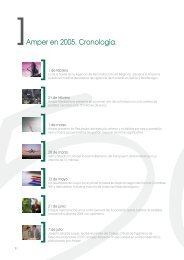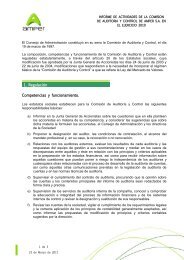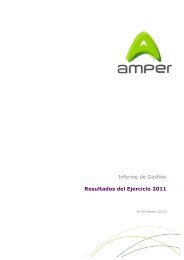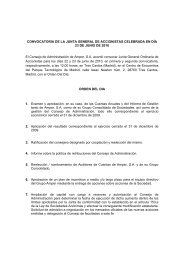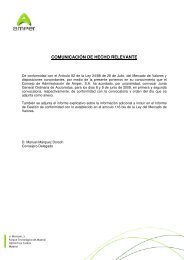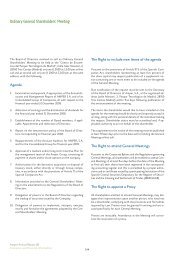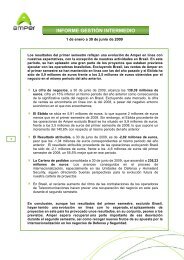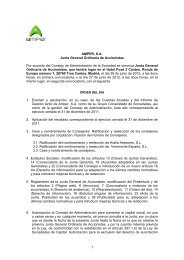AMPER, SA and Subsidiaries Consolidated Financial Statements for ...
AMPER, SA and Subsidiaries Consolidated Financial Statements for ...
AMPER, SA and Subsidiaries Consolidated Financial Statements for ...
You also want an ePaper? Increase the reach of your titles
YUMPU automatically turns print PDFs into web optimized ePapers that Google loves.
The consolidated financial statements of the Amper Group <strong>for</strong> 2011 were prepared on the basis of the<br />
accounting records kept by the Company <strong>and</strong> by the other Group companies. Each company prepares<br />
its financial statements according to the accounting principles <strong>and</strong> criteria in <strong>for</strong>ce in the country in<br />
which it carries out its operations. There<strong>for</strong>e, the necessary adjustments <strong>and</strong> reclassifications have<br />
been made in the consolidation process to ensure homogeneity among these principles <strong>and</strong> criteria to<br />
make them compliant with IFRSs.<br />
The <strong>Consolidated</strong> <strong>Financial</strong> <strong>Statements</strong> <strong>for</strong> 2010 included <strong>for</strong> comparative purposes were also prepared<br />
in accordance with the IFRSs adopted by the European Union that are consistent with those applied in<br />
2011.<br />
Based on the expectations arising from the application of the approved business plan, <strong>and</strong> considering<br />
the progress made in renegotiating the debt with financial entities during 2011, the Directors consider<br />
that the application of the principle of 'going concern' is suitable in the preparation of the <strong>Financial</strong><br />
<strong>Statements</strong>.<br />
2.3 Responsibility <strong>for</strong> in<strong>for</strong>mation, estimates made <strong>and</strong> litigation relevant to the application of<br />
accounting policies<br />
The in<strong>for</strong>mation contained in these <strong>Consolidated</strong> <strong>Financial</strong> <strong>Statements</strong> is the responsibility of the<br />
Administrators of the Group.<br />
In preparing the <strong>Consolidated</strong> <strong>Financial</strong> <strong>Statements</strong>, estimates made by the Group's management were<br />
occasionally used to quantify some of the assets, liabilities, revenues, expenses <strong>and</strong> commitments that<br />
appear in them. Basically, these estimates refer to:<br />
• The appraisal of assets <strong>and</strong> goodwill to determine the existence of losses due to impairment<br />
(Notes 3a <strong>and</strong> 3d), <strong>and</strong> also the recoverable sum of assets through deferred tax (Note 4l).<br />
• The working life of the tangible <strong>and</strong> intangible assets (Notes 3b, 3c).<br />
• The hypotheses used to calculate the fair value of the financial instruments (Note 3e).<br />
• The probability of occurrence <strong>and</strong> the amount of liabilities of an indeterminate sum or<br />
contingent liabilities (Note 3i).<br />
• Provision <strong>for</strong> unissued invoices <strong>and</strong> unreceived invoices.<br />
• Income from contracts is recognized using the degree of completion method. This method is<br />
based on estimates of the degree of completion of the project. Depending on the methodology<br />
used to determine the progress of the project, the significant estimates include total contract<br />
cost, the costs required to complete the works, total income from the contract, contract risks <strong>and</strong><br />
other litigation (Note 3j).<br />
Despite the fact that these estimates were made on the basis of the best in<strong>for</strong>mation available at the<br />
time of preparation of this <strong>Consolidated</strong> <strong>Financial</strong> <strong>Statements</strong>, based on the facts analysed, it is<br />
possible that events may take place in the future that could oblige us to modify them (upwards or<br />
downwards) in subsequent financial years. This would be done prospectively according to IAS-8,<br />
recognising the effects of changed accounting estimates on future consolidated financial statements.<br />
10



